List of secondary artifacts
The following are named artifacts, legendary artifacts, or those that have significant roles within the storyline.
Avishkar
Artifacts originating from or first seen on the plane of Avishkar.
Aetherwing
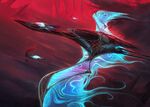
The Aetherwing is a legendary vehicle and the Golden-Scale Flagship seen on Avishkar during its invasion by the Phyrexians. It was built by Saheeli who was inspired by Ixalan's pterodons having a sleek shape similar to the winged dinosaurs. It is an air ship powered by aether. It gains power equal to the number of artifacts the player controls. It is associated with red and blue mana.
- Represented in:
Pyromancer's Goggles

The Pyromancer's Goggles are legendary magical googles that were a holy relic of Keral Keep that once belonged to Jaya Ballard. They were inherited by Chandra who treasures her mentor’s goggles, not for their magical properties, but for the memory of the woman who taught her to truly harness the power of fire.
- Represented in:
- Depicted in:
- Chandra, Bold Pyromancer (Dominaria)
- Chandra, Torch of Defiance (Comic-Con)
- Fight with Fire (Dominaria)
- Jaya Ballard (Dominaria)
- Jaya Ballard (Mythic Edition)
- Jaya Ballard (Secret Lair, #1062)
- Jaya Ballard, Task Mage (Time Spiral)
- Jaya, Fiery Negotiator (Dominaria United, #133)
- Jaya, Fiery Negotiator (Dominaria United, #374)
- Jaya's Greeting (War of the Spark)
- Jaya's Immolating Inferno (Secret Lair, #1063)
- Past in Flames (Signature Spellbook: Chandra)
- Pyretic Ritual (Secret Lair, #1064)
- Repercussion (Secret Lair, #1065)
Skysovereign
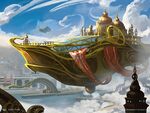
The Skysovereign is a legendary vehicle and the Consul Flagship from Avishkar. It is a large golden sky ship featuring several buildings on top of it. Whenever it enters or attacks it deals damage to creatures or planeswalkers under the opponent's control. It was used as a skinned card for Da Vulcha from the Warhammer 40,000: Orks Secret Lair.
- Represented in:
Dominaria
Artifacts originating from or first seen on the plane of Dominaria.
Helm of the Host
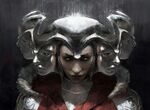
The Helm of the Host is a legendary equipment from Dominaria and is the helm of the queen of Vesuva. It was worn by Omo in the Multiverse and by Solaflora in the Un-iverse.[1] It is an open face metal helm with four additional faces on its front, two along each side of the wearer's face. It creates token copies of the equipped creature.
- Represented in:
- Depicted in:
Mox Amber
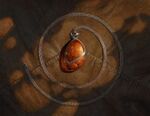
The Mox Amber is a legendary mox from Dominaria comprised of amber held as a pendent of a necklace. It is said to be a moment in time made tangible that has the power to realize epic visions. It adds one mana of any color among legendary creatures and planeswalkers the player controls.
- Represented in:
Thran Temporal Gateway
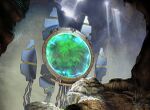
The Thran Temporal Gateway is a legendary artifact seen on the plane of Dominaria. It is a Thran portal from the past. It is comprised of a metal circle with a green energy portal inside of it. It allows casting of historic permanents from the player's hand to the battlefield for 4 colorless mana.
- Represented in:
Timeless Lotus
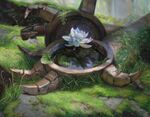
The Timeless Lotus is a legendary artifact and lotus seen on the plane of Dominaria near the time of the Second Phyrexian Invasion of Dominaria. It isis a lotus growing out a relic of one of Urza's past war machines. It was said that after he used nature to power his vast war machines, nature returned by exploiting their remains to renew itself. It appears as a glowing white lotus growing out of the metal hand of a destroyed machine. It can add a mana of all five colors.
- Represented in:
Duskmourn
Artifacts originating from or first seen on the plane of Duskmourn.
Marina Vendrell's Grimoire

Marina Vendrell's Grimoire is a legendary artifact from Duskmourn and as its name suggests the personel grimoire of Marina Vendrell, the warlock whose contract with Valgavoth led to the creation of Duskmourn. It is a worn black and brown book with a drawing of valgavoth on the front and little moth accents in each corner. As a card it introduces an alternate loss condition for the player by allowing them to have 0 or less life and only lose when they have no cards in their card. They then gain cards along with life gain and must discard cards for life lost.
- Represented in:
Innistrad
Artifacts originating from or first seen on the plane of Innistrad.
Mask of Griselbrand
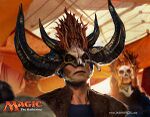
The Mask of Griselbrand is a legendary equipment and mask from Innistrad made to resemble the head of the demon Griselbrand. It grants flying and lifelink and is associated with black mana.
- Represented in:
Ixalan
Artifacts originating from or first seen on the plane of Ixalan.
Enigma Jewel
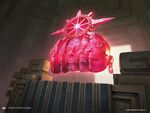
The Enigma Jewel is a legendary artifact seen on the plane of Ixalan. It is a metallic cross section of a face that glows red. Connected above the fact is a circle with a red jewel at its center. It transforms into the Locus of Enlightenment. It creates 2 colorless mana that can only be spent on activated abilities. It is associated with blue mana.
- Represented in:
Indomitable
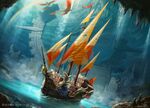
The Indomitable is a legendary vehicle seen on the plane of Ixalan. It is a named pirate ship. It can be cast from the graveyard if the player has three or more tapped pirates or vehicles. It is associated with blue mana.
- Represented in:
Locus of Enlightenment
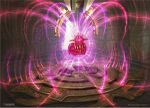
The Locus of Enlightenment is a legendary artifact from Ixalan that is created from the Enigma Jewel. It is a metallic cross section of a face that draws in glowing red energy into it. It has all of the activated abilities of those non-lands used to craft it and copies any activated ability to be triggered again. It is associated with blue mana.
- Represented in:
Millennium Calendar

The Millennium Calendar is a legendary artifact from Ixalan. It is a giant metal calendar that keeps track of time on the plane. It builds up time counters and has an ability to double them. It can be sacrificed after 1000 of the counters are on it to cause each opponent to lose 1000 life.
- Represented in:
Skullspore Nexus

The Skullspore Nexus is a legendary artifact from Ixlan that appears to be a stone dias on the ground with a dinosaur skull in it's center that hash a large amount of mushrooms and glowing fungi growing out from it. It creates Fungus Dinosaurs whenever other creature's die near it with their power & toughness being equal to the total power & toughness of the dead creatures. It also has an activated ability to double a target creature's power. It is associated with green mana.
- Represented in:
Tarrian's Soulcleaver
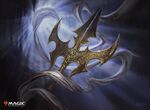
Tarrian's Soulcleaver is a legendary equipment from Ixlan. It is a holy lance that was originally carried by the Venerable Tarrian. It was later acquired and used by by Vito Quijano de Pasamonte who brought it into Ixalan's Core. It was then stolen by Huatli who used it to kill Vito. It grants vigilance to whomever wields it and empowers them with +1/+1 counters whenever another creature or artifact enters the graveyard from the battlefield.
- Represented in:
- Depicted in:
Thaumatic Compass

The Thaumatic Compass is a legendary artifact from Ixlan. It is a silver compass that points toward planeswalking magic.[2][3] It is made up of a series of stacks of circles and etchings, with one long point extending from an empty ring on its side.[4] Nicol Bolas gave the compass to Vraska on the Meditation Plane to assist her in finding the Immortal Sun in the city of Orazca on Ixalan.[5] After finding the city, Vraska kept the compass in her apartment on Ravnica.
- Represented in:
- Depicted in:
Kaldheim
Artifacts originating from or first seen on the plane of Kaldheim.
Esika's Chariot
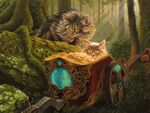
The Esika's Chariot is a legendary vehicle from Kaldheim and the chariot of Esika, the God of the Tree. Esika and Inga rode it to battle during the New Phyrexian Invasion. Rather then horses, it is pulled by two cats. To represent this by creating two green cat tokens when it enters. It also creates copies of tokens when it attacks.
- Represented in:
- Depicted in:
Harnfel
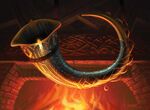
Harnfelt is a legendary artifact from Kaldheim known as the horn of bounty. It is the horn of Birgi, the God of Storytelling. It is a curved golden horn that is associated with red mana.
- Represented in:
- Depicted in:
Kaldring
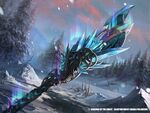
Kaldring is a legendary snow artifact from Kaldheim known as the Rimestaff. It is the staff of Jorn, the God of Winter. It is a staff with ice crystals coming out of the top which are said to have come from from every realm Jorn has visited. It is associated with blue & black mana and has an activated ability to play snow permanents from the graveyard.
- Represented in:
- Depicted in:
Omenkeel
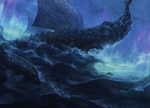
The Omenkeel is a legendary vehicle from Kaldheim. It is the ship of Cosima, the God of the Voyage. It travels atop the water with a sail.
- Represented in:
- Depicted in:
Ringhart Crest
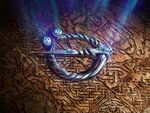
The Ringhart Crest is a legendary artifact from Kaldheim. It is the Crest of Kolvori, the God of Kinship.
- Represented in:
Valkmira
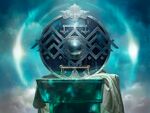
The Valkmira is a legendary artifact and shield from Kaldheim known as the Protector's Shield. It is the shield of Reidane, the God of the Worthy. It prevents one damage off of any source of damage being dealt to the player or a permanent under the player's control. It also counters any spells targeting the player or player's permanent unless the opponent pays an additional mana.
- Represented in:
- Depicted in:
Kamigawa
Artifacts originating from or first seen on the plane of Kamigawa.
Eater of Virtue
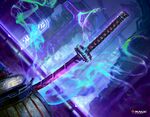
The Eater of Virtue is a legendary vehicle from Kamigawa from the modern Neon Dynasty era. It a blade that eats the soul of those who die wielding it. If a creature dies while equipped, they are exiled and then the sword will grant the next equipped creature its evergreen keyword abilities like flying or vigilance.
- Represented in:
Meditation Plane
Artifacts originating from or first seen on the Meditation Plane.
Gem of Becoming

The Gem of Becoming is a legendary artifact and gem on the Meditation Plane, similar to and possibly connected to the Spirit-Gem.[6]
- Represented in:
- Depicted in:
Mirrodin / New Phyrexia
Artifacts originating from or first seen on the plane of New Phyrexia or former plane of Mirrodin.
Mindslaver

The Mindslaver is a legendary artifact from Mirrodin that is a metal helmet that mind controls the wearer. It covers the top of their head and eyes with wires going into their neck. It was the first card to allow controlling another player.
- Represented in:
Ravnica
Artifacts originating from or first seen on the plane of Ravnica.
God-Pharaoh's Statue
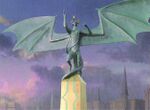
The God-Pharaoh's Statue is a legendary artifact from Ravnica during the War of the Spark. It was a statue of Nicol Bolas that was later toppled by Vitu-Ghazi during the war.
- Represented in:
- Depicted in:
Tarkir
Artifacts originating from or first seen on the plane of Tarkir.
Dragon Throne of Tarkir
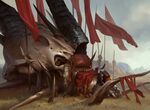
The Dragon Throne of Tarkir is a legendary artifact and equipment from Tarkir's original timeline. It acts as the throne of the leader of the Mardu Horde and was formed from Kolaghan's skull. It gives the equipped creature Defender and has an activated ability to give other creatures trample and a power & toughness increase based on the equipped creature's power.
- Represented in:
Theros
Artifacts originating from or first seen on the plane of Theros
Akmon, the Hammer of Purphoros
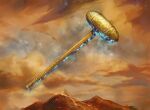
The Hammer of Purphoros, named as Akmon, is a legendary enchantment artifact from Theros. It is a massive hammer whose head resembles an anvil wielded by Purphoros, the God of the forge, fire, and restless earth. A single strike from Akmon can melt earth into molten lava, and when it strikes metal, each spark can become a new enchantment, some capable of taking on life. Purphoros used Akmon to forge legendary beings such as the oreads, said to be formed from stray coals of his forge[7], and the manticore, whose bronze tail, silver teeth, and heart of hate were all crafted by the forge god.[8]
- Represented in:
Ephixis, the Bow of Nylea
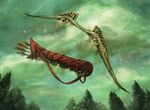
The Bow of Nylea, named as Ephixis, is a legendary enchantment artifact from Theros. It is a shortbow wielded by Nylea, the God of the Hunt, Seasons, and Wilds. It is said that an arrow from the bow never fails to find its mark.[9] The nymph Theophila, Nylea's companion, conjures illusions for target practice, such as fireflies or minuscule silkworms. Nylea permits predation, but she hates hunting for sport: she kills poachers in the Nistos Forest who don't ask for her blessing to hunt her animals herself. Nylea watches over all the creatures of the forests, except snakes, which, thanks to the blessing of Pharika, can take care of themselves.[10]
- Represented in:
Khrusor, the Spear of Heliod
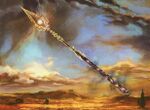
The Spear of Heliod, named as Khrusor, the Sun Separ, is a legendary enchantment artifact from Theros wielded by Heliod, the God of the Sun. It is a spear blessed with his power that could be pitched down from the heavens to any point on Theros. Obscure legends say that Heliod smote the coastal city known as Arixmethes with Khrusor and cast it into the sea. During her time in the Underworld, reliving her death every night, Elspeth was able to seize the shadow of Khrusor from her nightmares and bring it into the Underworld as the Shadowspear. Victory after victory, she declared to onlookers that her spear was the real Khrusor and Heliod's was a fake. As the legend of Elspeth's spear grew, Khrusor's strength waned. When she finally battled Heliod at the gates of the Underworld, his spear shattered in his hands.
- Represented in:
Mastix, the Whip of Erebos
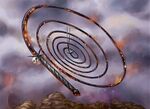
The Whip of Erebos, named as Mastix, is a legendary enchantment artifact from Theros. It is a golden-handled whip with an impossibly long lash used by Erebos, the God of Death.[11] The whip is a means of inflicting pain when he must, but its more frequent function is as a snare to pull the reluctant dead into his realm.
- Represented in:
Nyx Lotus

The Nyx Lotus is a legendary artifact from Theros. It is a lotus located in Nyx that appears a a large pink & purple flower with energy waves coming off of it. It allows the player to choose a color and then adds mana equak to the player's devotion to that color.
- Represented in:
The Edge
Artifacts originating from the Edge.
Dominion Bracelet
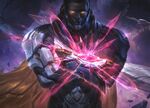
The Dominion Bracelet is a legendary artifact from the Edge. It is Sunstar Free Company equipment that appears as a white metallic bracelet with red crystal on it that emits energy. It is an allusion to the eponymous Lens from the Lensman series by American author E. E. "Doc" Smith.[12]
- Represented in:
Eternity Elevator

The Eternity Elevator is a massive legendary artifact from the Edge that rises from a planet into space. It is a Pinnacle Eternity column based on the real-world concept of space elevators, thousands-of-kilometers-long structures used for launching ships into space.
- Represented in:
Unknown
Artifacts originating from an unknown plane in the Multiverse.
Chromatic Orrery

The Chromatic Orrery is a legendary artifact from an unknown location in the multiverse. It is a model of New Phyrexia with spheres representing the plane and its moons. It was located in public location where visitors would marvel at its design but were unaware of the other world that inspired it.
- Represented in:
Terminus of Return

The Terminus of Return is a legendary Terminus Stone located on an unknown plane. It appears as a large black rock jutting out of the ground with a pattern carved into that that glows with purple light. It is indestructable, associated with black mana, and can be activated by exiling a creature. Once activated, it brings creatures back to life. It is presumed to be one of six such legendary stones.
- Represented in:
Tome of the Infinite
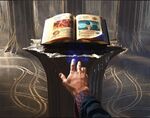
The Tome of the Infinite is a legendary artifact and book from an unknown location in the multiverse. It is a book that contains numerous powerful spells within it including Swords of Plowshares, Light of Hope, Ponder, Force Spike, Dark Ritual, Duress, Lightning Bolt, Assault Strobe, Giant Growth, and Fog. It is associated with blue mana.
- Represented in:
Un-iverse
Artifacts originating from the Un-iverse.
Kindslaver
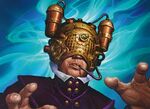
The Kindslaver is a legendary artifact from Bablovia in the Un-iverse. It is a mechanical helmet that goes over a humanoid head with two containers of liquid on each side that feed into the mouth with tube. It is a reference to the Mindslaver in the main multiverse. When sacrificed, it gives a player outside the game control over a target player's turn with neither the casting player or targeted player able to give advice.
- Represented in:
Minor artifacts
The following artifacts are only mentioned in flavor text, or appear as minor artifacts in the storyline.
| Name | Plane | Description | Cards |
|---|---|---|---|
| Backstab | Dominaria | Ship of Bo Levar. | |
| Burning Vengeance | Dominaria | Sisay's first ship. | |
| New Tolaria | Dominaria | Used after the island's destruction. | |
| Serafina | Dominaria | A drowned ship originally captained by Soll. | Drowned (The Dark) |
| Sword of Faith | Dominaria | ||
| Sword One | Dominaria | A sword-pattern avenger prototype piloted by Sanwell. Built c. 28 AR. Fought in the Siege of Kroog in 28 AR. | |
| Sword Two | Dominaria | A sword-pattern avenger prototype piloted by Rica. Built c. 28 AR. Destroyed by Fallaji brasscaps during the Siege of Kroog in 28 AR. | |
| Sword Three | Dominaria | A sword-pattern avenger prototype piloted by Carlo. Built c. 28 AR. Destroyed by Fallaji brasscaps during the Siege of Kroog in 28 AR. | |
| Sword Four | Dominaria | A sword-pattern avenger prototype. Built c. 28 AR. Destroyed by Fallaji brasscaps during the Siege of Kroog in 28 AR. | |
| Sword Five | Dominaria | A sword-pattern avenger prototype. Built c. 28 AR. Destroyed by Fallaji brasscaps during the Siege of Kroog in 28 AR. | |
| Wave Splitter | Dominaria | A Kukemssan privateer captained by Jelamau. | |
| Wavespawn | Dominaria | A pirate ship. | |
| PSS Erix | The Edge | A Pinnacle spacecraft. Its name is a reference to Saffi Eriksdotter. |
|
| Everflame | Eldraine | A legendary sword embedded in the Irencrag. A reference to the "Sword in the Stone" tale of Excalibur. | |
| Blood Anchor | Ixalan | Under Bennell Dardan. | |
| Devil's Chains | Ixalan | Under Angrath | |
| Diremore | Ixalan | Under Brandis Thorn | |
| Gunwhale | Ixalan | A Brazen Coalition ship used by Caztaca Huicintli | |
| Hangman's Noose | Ixalan | Under Sedden Dray | |
| Her Majesty's Courage | Ixalan | Under Mavren Fein | |
| Leviathan's Wrath | Ixalan | Under Ripley Vance | |
| Salty Dog | Ixalan | Taken by the Diremore | |
| Scourge | Ixalan | Under Admiral Beckett Brass, which later became one of the founding ships of High and Dry. | |
| Second Scourge | Ixalan | Brass's second ship | |
| Squid Eyes | Ixalan | Another ship that later became one of the founding ships of High and Dry. | |
| Standing Rock | Ixalan | Under Fole Demeer | |
| Sunset Wave | Ixalan | Under Oljin Raye | |
| Tide Turner | Ixalan | Under Wallis Parrish | |
| Tormented Doubloon | Ixalan | taken by Vraska | |
| Ugly Mug | Ixalan | taken by the Diremore | |
| Windbinder | Ixalan | Under Kalishah Abban | |
| Windshark | Ixalan | ||
| Witch's Windlass | Ixalan | Under Farrien Goss | |
| Brass Hammer | Kaladesh | a ship in Karpani Zevanwat's fleet | |
| Cold Wind | Kaladesh | a ship in Zev's fleet | |
| The Demon of Vahd | Kaladesh | a ship in Zev's fleet | |
| Dragon's Smile | Kaladesh | Zev's flagship | |
| Kite | Kaladesh | A ship in Zev's fleet | |
| Sun Chaser | Kaladesh | Zev's first ship | |
| Icecutter | Kaldheim | An Omenseeker ship | |
| Crescent of Morningtide | Lorwyn-Shadowmoor | An ancient relic empowered by a great elemental, that could bridge the gap between Lorwyn and Shadowmoor without changing.[13] | |
| Recreant | Rath | Under Volrath | |
| Cloud-Lifter | Ravnica | a quadrotor | |
| Heckless | Ravnica | a pirate ship | |
| Philomachos[14] Bulwark of Brotherhood |
Theros | A battle-worn bronze shield carried by Iroas.[15] It symbolizes the protective bond shared by all soldiers at war and his determination. It was used by Rygyra the Slinger to defeat the minotaur Raksolcs Ravage-Soul. | |
| Epiphany | Theros | A gleaming javelin carried by Keranos.[15] After Keranos channeled his anger into a storm, Purphoros captured the storm and smithed the weapon from it. When Keranos wants to send a message, Epiphany is his tool of choice. | |
| Hadross | Theros | Under Vog | |
| Katabasis | Theros | Athreos's ancient staff, which can transform into the ferryboat he uses to cross the Rivers That Ring the World. It shares its name with the Ancient Greek term for a journey to the underworld. | |
| The Monsoon | Theros | Under Callaphe | |
| Pyleas | Theros | Under Siona | |
| Wrathbringer | Theros | Mogis's black iron greataxe. Shortly after his birth, Mogis decided to create a weapon with which to kill his brother.[15] Mogis assembled his champions and sent them out to battlefields, where they collected the essences of rage, hatred, and bloodlust. Under a blood-red moon, Mogis used those ingredients to forge a weapon of manifest violence. |
References
- ↑ Mark Rosewater (December 9, 2022). "Drive to Work #991 - Names & Favor Text with Ari Zirulnik, Part 2". Tumblr.com.
- ↑ R&D Narrative Team (October 4, 2017). "Something Else Entirely". magicthegathering.com. Wizards of the Coast.
- ↑ R&D Narrative Team (October 11, 2017). "The Race, Part 1". magicthegathering.com. Wizards of the Coast.
- ↑ Alison Lührs (March 24, 2023). "March of the Machine - Ravnica: One and the Same". magicthegathering.com. Wizards of the Coast.
- ↑ R&D Narrative Team (September 20, 2017). "The Talented Captain Vraska". magicthegathering.com. Wizards of the Coast.
- ↑ Monty Ashley (August 23, 2012). "What's That Gem?". magicthegathering.com. Wizards of the Coast. Archived from the original on March 1, 2019.
- ↑ Flavor text of Forgeborn Oreads (Journey into Nyx).
- ↑ Flavor text of Dreamstalker Manticore (Theros Beyond Death).
- ↑ Flavor text of Plummet (Theros Beyond Death)
- ↑ Flavor text of Moss Viper
- ↑ (2013). Theros Player's Guide. Wizards of the Coast.
- ↑ Ethan Fleischer (July 10, 2025). "Edge of Eternities Design: Allusions vs. Tropes". magicthegathering.com. Wizards of the Coast.
- ↑ Neale LaPlante Johnson, DK Billins, Laurel Pratt (September 26, 2025). "Planeswalker's Guide to Lorwyn Eclipsed". magicthegathering.com. Wizards of the Coast.
- ↑ Jennifer Clarke Wilkes (Nov 6, 2013). "I Iroan". magicthegathering.com.
- ↑ a b c Wizards RPG Team (2020), D&D Mythic Odysseys of Theros, Wizards of the Coast